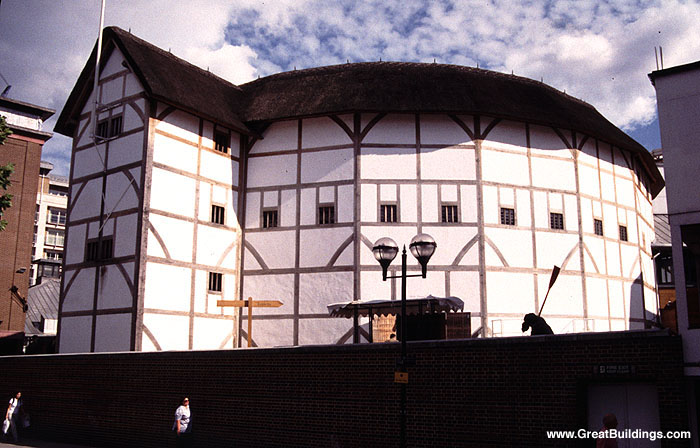|
;The original Globe Theatre was a wood-framed building with plastered outside walls joining at angles to form a circle or an oval. The interior resembled that of a modern opera house, with three galleries protected from rain and sunlight by a roof. Between 2,000 and 3,000 playgoers paid two or more pennies to sit in these galleries, depositing them in a box. The stage was raised four to six feet from ground level and had a roof supported by pillars. In front of the stage was a roofless yard for up to 1,000 "groundlings" or "stinklings," who paid a "gatherer" a penny to stand through a performance under a hot sun or threatening There was no curtain that opened or closed at the beginning or end of plays. At the back of the stage, there was probably a wall with two or three doors leading to the dressing rooms of the actors. These rooms collectively were known as the "tiring house." The gallery had a thatched roof.During a performance of Henry VIII on June 29, 1613, the Globe Theatre burned down after booming canon fire announcing the entrance of King Henry at Cardinal Wolsey's palace ignited the roof.The Globe Theatre was constructed in 1599, out of timber taken from the Theatre. It stood next to the Rose, on the south side of the Thames, and was the most elaborate and attractive theatre yet built. The Globe was the primary home of Shakespeare's acting company beginning in late 1599, and it is a possibility that As You Like It was written especially for the occasion. The new Globe theatre lasted until 1644, at which time it was demolished, and housing was quickly built where it once stood. Recent attempts have been made to re-create the Globe, and replicas have been built in Tokyo and in London.The exterior appearance of the Globe can only be pieced together from sketches of the theatre found in sweeping Elizabethan city scenes, and the interior appearance from the drawing of the Swan Theatre. From these images we can describe the Globe as a hexagonal structure with an inner court about 55 feet across. It was three-stories high and had no roof. The open courtyard and three semicircular galleries could together hold more than 1,500 people
|
|
